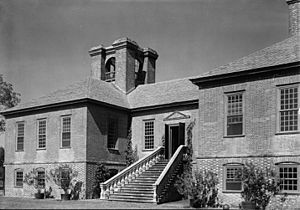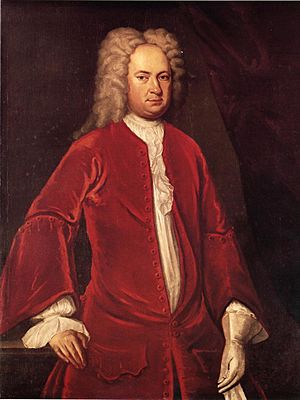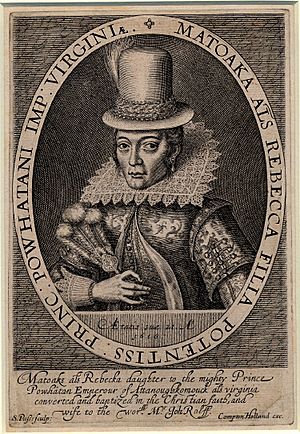First Families of Virginia facts for kids

The First Families of Virginia (FFV) were important and wealthy families in Colonial Virginia. They were not always the very first settlers. These families came from English colonists who mostly settled in places like Jamestown and Williamsburg during the 1600s.
These powerful families often married people from similar social backgrounds. Because of this, many of their family names go back to the colonial period.
The American Revolution broke ties with Britain. But it did not change Virginia's social traditions. Some FFV members supported Britain. Others were leaders in the Revolution. Most First Families stayed in Virginia. They became rich by growing tobacco. They also sold enslaved people to farms further south. Many younger sons moved to the "cotton belt" to start their own farms.
After the Civil War, enslaved people were freed. Virginia farms struggled without this free labor. The First Families became poorer. But they still held social and political power. By the 1950s, they were still strong. They started using modern farming methods. They also welcomed wealthy people from the North into their upper-class country life.
Contents
How Virginia's First Families Started

The English colonists who became the First Families of Virginia came to the new Colony of Virginia. They arrived between the founding of Jamestown and the English Civil War (1642–1660). Some royalists left England when Oliver Cromwell took power.
Many early Virginia settlers supported King Charles II. After King Charles I was executed in 1649, Charles II called Virginia his "Old Dominion." This nickname is still used today. Many early Virginia settlers were called "distressed Cavaliers." These were people who supported the King. Some Cavaliers who fought for King Charles I moved to Virginia. The First Families often call Virginia "Cavalier Country."
Many early settlers were "Second Sons." In England, the oldest son usually inherited all the land and titles. Younger sons often went to the colonies to make their own wealth. They might also join the military or the church. Virginia's "Tidewater" region grew with people descended from these younger sons. They received land grants in Virginia. They became part of the powerful group in Colonial America.
Families in England often had strong ties. These connections continued in the new colony. They were made stronger through marriages. For example, the Spencer family and the Washington family had old ties. A Spencer helped the Washingtons get the land where they built their Mount Vernon home. These connections were common. Families traveled between England and Virginia. They kept their ties with their home country and with each other.
A small group of related families held power in colonial Virginia. They were the wealthy farm owners. A British historian named John Keegan wrote that by 1660, members of just five related families held every seat on Virginia's ruling Council. By 1775, every council member was related to someone from the 1660 council.
Family ties in Virginia were often based on marriage. Before the American Revolution, the economy depended on growing tobacco. Owning the best land was very important. Land often passed between families of similar social standing. Virginia's economy relied on the labor of enslaved people. This allowed the wealthy landowners to keep political power. Power often passed smoothly from one family to another. In the North, where there was more trade, new wealthy people could gain power more easily.
Pocahontas and Her Legacy
Pocahontas (1595–1617) was a Native American woman. She was the daughter of Chief Powhatan. He was the leader of the Powhatan Confederacy.
Pocahontas was captured by Englishmen in 1613. She was educated among the English. She also became a Christian. Pocahontas married colonist John Rolfe in Jamestown in 1614. Rolfe became rich by growing new types of tobacco. This tobacco was the first successful export cash crop for the colony. Their only child, Thomas Rolfe, was born in 1615. Thomas married and had children. His descendants later married into other important families.
Pocahontas was very famous in London. She was welcomed with great honor at the Royal Court. She died young. But she became a legend. She was the first known Native American from Virginia to become Christian, marry an Englishman, and have a child with him. She became an important symbol of good relations between Native Americans and the English in Jamestown. Her story was often made into romantic tales. It became a big part of early American history.
Honoring Virginia's History
After the Civil War, during the Reconstruction era, Virginia Governor Wyndham Robertson wrote a history of Pocahontas and her descendants in 1887. This book traced the family lines of many First Families of Virginia. It included families like the Bollings, Blands, and Randolphs.
Families often used surnames as first names. For example, a mother's maiden name might be used as a "middle name." This helped show a person's family background.
In 1907, the Jamestown Exposition was held near Norfolk. It celebrated 300 years since the first English colonists arrived in Jamestown. Preservation Virginia is a group that works to protect Virginia's history. It was started in 1889. In the 1900s, this group focused on showing patriotism. They highlighted the Founding Fathers who came from Virginia.
Notable First Families of Virginia
Some well-known family names include:
- Allerton
- Archer
- Baskerville
- Bentley
- Berkeley
- Beverley
- Billingsley
- Blair
- Bland
- Bolling
- Branch
- Braxton
- Browne
- Buckner
- Burwell
- Byrd
- Capps
- Carter
- Cary
- Chiles
- Conway
- Dameron/Damron
- Dandridge
- Dalton
- Dudley
- Duke
- Eldridge
- Fairfax
- Farrar
- Fitzhugh
- Gooch
- Goode
- Graves
- Hardy, Mary Pinkney
- Harris
- Harrison
- Hopkins
- Jefferson
- Jenings
- Kennon
- Lee
- Madison
- Marshall
- Mathews family
- Maupin
- Morgan
- Nash
- Nelson
- Page
- Payne
- Randolph
- Robinson
- Rolfe
- Saunders
- Selden
- Sharp
- Shifflett family
- Skillern
- Spencer
- Stagner
- Starnes
- Stith
- Taliaferro
- Tayloe
- Taylor
- Waller
- Warner
- Warren
- Washington family
- West


